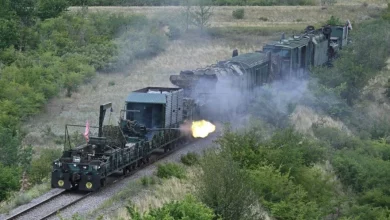Analysis: Ukraine war shows limits of drone warfare

In early June, as the U.S. was rushing to provide financial and military support for Ukraine, reports said that four American-made Gray Eagle drones would be part of the package. These are armed drones that are larger than the well-known Predator drone, which became a symbol of the global war on terror.
However, the planned sale of these few expensive, complex drones has run into some hurdles because of concern that they might get shot down and their sophisticated systems could fall into Russian hands.
While the Pentagon isn’t elaborating on the status of the Gray Eagle sales, the overall challenge that Ukraine faces in using drones against Russia illustrates the limits of drone warfare. Over the past few decades, there have been many prophecies about how drones will “transform our lives,” from stories about drones making pizza deliveries to discussions about “drone swarms” that could be used to overwhelm enemies in combat.
When Russia invaded Ukraine, it put a renewed spotlight on the use of armed drones in conventional wars: The world saw how armed drones might work when both countries have them — and both have air defenses that can shoot them down. Previously, countries that had a plethora of drones generally were fighting wars against insurgents or groups/countries that didn’t have drones. This was the case with the U.S. experience in Afghanistan, for example.
Early reports from Ukraine said that Ukraine’s two dozen Turkish Bayraktar drones, a UAV that is smaller than the Predator, were able to take out Russian forces. One report praised these drones for changing the “nature of warfare.” However, now reports about the success of the Bayraktar in Ukraine have slackened. It’s unclear whether the drones are simply not operating near the new front lines in the Donbas, or whether they are running low on the missiles they use.
The nature of drone warfare is that it is clandestine; militaries don’t acknowledge that their drones may not be working well. In a conflict where everyone has smartphones, if drones are being used someone probably will take videos of them. This is because drones tend to be loud, like a flying lawnmower, and you can often see or hear them from the ground. The Associated Press reported that a video posted online on June 22 showed an alleged Ukrainian kamikaze drone flying into a Russian refinery.
Western countries want to supply Ukraine with armaments and a variety of drones are on the shopping list, including kamikaze drones such as the small Switchblade made in the U.S. These won’t turn the tide anytime soon.
In eastern Ukraine, where fighters in Kyiv face a tough battle with Russian troops, the limits of drone warfare appear to be on display. Conventional weapons, such as masses of artillery, are wreaking havoc. With only a few complex armed drones, Ukraine can’t afford to use or lose its drones.
No miracle tech needed: How to switch to renewables now and lower costs doing it
America’s newest national security threat: Obesity
The “era of the drone” hasn’t arrived because countries that use them often don’t deploy enough of them, or are afraid to lose them in battle. In conflicts where they have been used, such as in Libya, they didn’t turn the tide.
Despite widespread employment, drones didn’t stop the Taliban in Afghanistan. One can blame wider political policies for this result, asserting that countries simply haven’t given drone operators free rein to use them successfully.
Nevertheless, the current limitations on use of drones in war is related to the supply of drones and operating guidelines for their use. To wage a large-scale drone war, the countries that use them need more than a few armed drones — and they need to not fear losing some of them. The whole point of unmanned aerial vehicles is that they can be used for dull, dirty, dangerous missions, especially those in which a country doesn’t want to risk sacrificing pilots.





